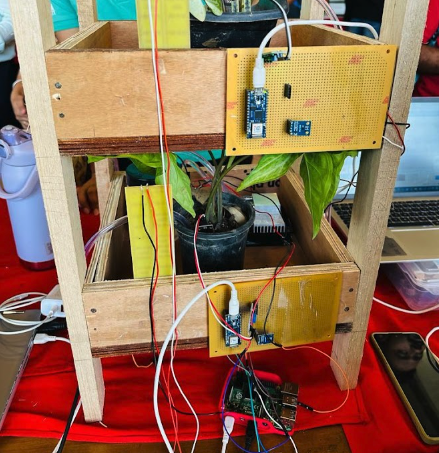“The inspiration came from the need to address the challenges in traditional farming and leverage technology for efficient crop management,” Tanay explains. “It’s a forward-thinking approach to agriculture and my project was born out of a passion for sustainable agriculture. The aim was to explore innovative solutions, driven by a desire to contribute to a greener future.”
Making sense
Although Tanay has not had first-hand experience of vertical farming, he says he has read lots about it. “It’s a fascinating concept,” he adds. His research meant he had a good idea of what was needed to create his own system. “Raspberry Pi was chosen for its versatility, affordability, and the vast community support it offers,” Tanay says. “It’s a robust choice for managing and controlling various components in a system like this.”
These components include ambient light, soil moisture, and water level depth detection sensors. “The project was planned by first identifying the key requirements, such as real-time monitoring, efficient water supply, secure communication, and a user-friendly interface,” Tanay continues. “Components were selected based on their compatibility and functionality within the system.”
The sensors gather data about the plants. This data is then processed by a peripheral control unit (in this case an Arduino Nano 33 IoT) and sent to the central unit (Raspberry Pi 4) via Bluetooth Low Energy (BLE) communication. “The central unit makes decisions on actions such as activating actuators to adjust environmental parameters,” Tanay says. “This continuous loop ensures optimal conditions for crop growth.”
Friendly farming
A thermoelectric Peltier refrigeration cooling system kit has also been used. “A humidity-to-water conversion, with the help of the Peltier module device working on the principle of condensation, ensures a continuous supply of water,” Tanay explains. It ensures plants are kept alive and are able to thrive but there’s also a user-friendly GUI for remote manual control.
“The software was crafted with modularity and user-friendliness in mind,” says Tanay, who used the IoT platform ThingSpeak. “ThingSpeak is useful for visualising data from sensors in real-time which provides valuable insights to farmers,” he continues. “A user-friendly interface makes it accessible to those without extensive technical knowledge and providing a fault tolerance to the system.”
Tanay hopes the project will show that vertical farming doesn’t have to be expensive. “The project’s cost-effectiveness is a standout feature,” he says. It’s also scalable. “The project is aimed at small and large-scale farmers,” Tanay adds. “The modularity and scalability design principles suggest it’s adaptable to various farm sizes, making it accessible to a broad audience.”


Schreibe einen Kommentar
Du musst angemeldet sein, um einen Kommentar abzugeben.